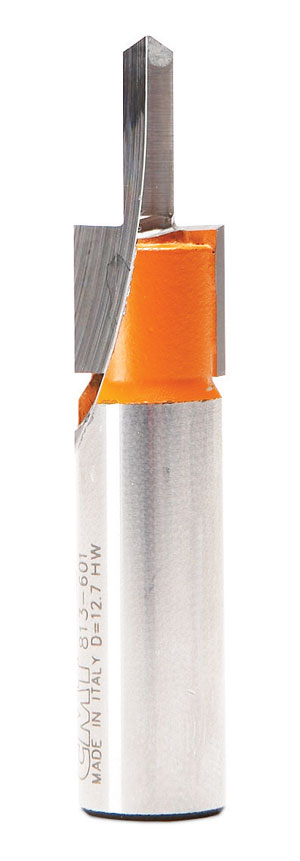We may receive a commission when you use our affiliate links. However, this does not impact our recommendations.
Feature-Rich, Powerful and Ergonomically Smart
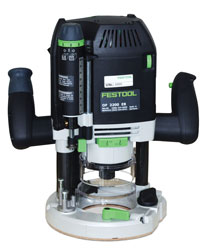
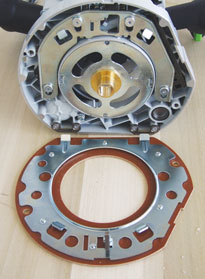
Festool set the bar high when it set out to develop the new OF2200 plunge router. An initial look at the machine suggests they made it over that bar with room to spare. To accomplish this, Festool took a fresh look at this workhorse of a tool, and developed the OF2200 to better fit the routing habits of woodworkers. The number of user-friendly features reads like a wish list. Here’s a quick run-down:
•Tool-free quick-release base plate – provides rapid changing of guide bushings and various accessory bases.
•30-degree-rotated base – positions the handles at a more ergonomic orientation to the work piece for routing.
•Ratcheting spindle lock – Festool has taken the much-appreciated spindle lock feature one step further by adding a ratcheting mechanism. This further simplifies the sometimes knuckle-banging job of changing bits.
•Other noteworthy features include a powerful 3-1/4 hp soft-start, self-braking variable speed motor, exceptional dust collection, double column clamping, over 3 inches of plunge, and fine adjustment in steps of 1/256 in.
Source
Festool, www.FESTOOLUSA.com, (888) 337-8600, Plunge router, OF2200, Available late spring or early summer 2008, price was not available at time of publication.
Three-Sided Molder
For years, the Woodmaster 12 in. Molder/Planer has been a faithful friend to small and medium-sized shops. It cuts a wide variety of moldings on the top surface of a board. Someone at Woodmaster just had a great idea: why not add two 3.5 hp Milwaukee routers to the machine and make three-sided moldings in a single pass? Well, they’ve figured it out. Three-sided molders are standard in large production shops, and cost many thousands of dollars. Woodmaster’s new system is far less expensive. A new 12 in. Woodmaster Molder/Planer with the 3-Side Molding System starts at $3,995. (The two routers can also be retrofitted to existing Woodmaster 18 in. and 25 in. molder/planers.) As you know, commercially-made molding can really add up in cost, and there’s a limited number of species available. With your own 3-sided molder, you can turn out hundreds of feet of tongue-and-groove flooring, crown molding, base molding, and more, for far less cost, and you can use any wood you want.
Source
Woodmaster Tools, www.woodmastertools.com, (800) 821-6651, 3-Side Molding System, $3,995.
 |
Eliminate Fuzzy Fillets
Freud’s new Quadra-Cut router bits produce routed profiles with little or no tear out or fuzz, even on cross-grain cuts. These unique, patented bits employ four cutting edges instead of two. The large profile cutters remove most of the stock with an upshear cut. Then a pair of downshear cutters makes the final cut to produce an ultra clean edge with no fuzz or splinters at the top surface. Freud is introducing the new Quadra-Cut technology in select edge-forming bits with 1⁄2 in. shanks. We got our hands on a roundover bit and tried it out on some red oak panels. The results were amazing. Both bits were brand new, but the difference in cut quality, especially at the fillet on the top, was quite noticeable. We made full-profile cuts in a single pass to really put the design to the test. The Quadra-Cut bit left a near-perfect surface requiring only a light sanding before finishing. A standard roundover bit left a lot of fuzz and tearout at the top of the fillet. Needless to say, we were very impressed with this bit design.
Source
Freud, www.freudtools.com, (800) 334-4107
 |
 |
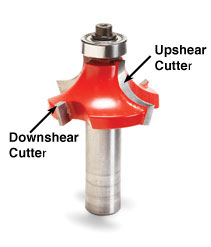
Upgrade Your Router Lift With Digital Accuracy & RepeatabilityThe Digi-Router is the newest member of the Digi-Kit family from Accurate Technologies. The Digi-Router is made in the U.S.A. and designed to retrofit JessEm and Bench Dog router lifts with other router lift models in the works. The Digi-Router permits router height adjustments to within 0.010 inches and the readout can be set for decimal inches, millimeters, or fractions. The fraction setting features a bar graph that shows height changes in 1/64 in. increments (Photo, at left). The remote LCD digital display has 1/2-in.-tall digits for easy reading. The system installs in under 30 minutes. It’s easy to calibrate, allowing you to start at zero or preset any starting position. You can also toggle between absolute and incremental readings at the push of a button. The Digi-Router comes with a 1-year warranty and a CR123 Lithium battery that lasts up to 24 months, plus full color installation and operation manuals.
Source
Accurate Technology, www.digi-kit.com, (800) 233-0580, Digi-Router, $150.
 |
 |
Hundred Jig In OneThe Router-Ease Guide is an American-made tool designed to meet the needs of both the weekend enthusiast and the professional.
The Router-Ease Guide functions as a two- or four-sided adjustable jig/template. The Router-Ease Guide eliminates downtime used to design and makes jigs or templates for particular routing tasks. It can be set for cutting dadoes, rabbets, hinge mortises, pocket mortises, fluting or sink cutouts in countertops. The Router-Ease Guide can even be used to cut dadoes on an angle, such as the short, stopped dadoes used in louvered shutters or doors. Two innovations make this guide easy to use: the Gauge Block and the Dado Block. Both are included with the Router-Ease Guide and are used to quickly and accurately set the guide arms. The Dado Block is used with a 1/2 in. straight bit and the included subbase. The Gauge Block is stepped to allow for the use of 1/2 in., 3/8 in., and 1/4 in. bits. Simply set the appropriate block along a guide arm, move the arm until the block touches your layout line and tighten the lock-down knob.
Available in three stock sizes and custom.
Source
REG, Inc., www.routereaseguide.com, Router-Ease Guide, $176 – $236 depending on size.
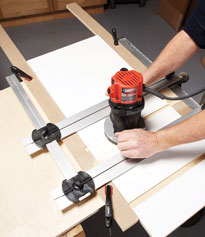 |
Double-Sided Insert Is Like Two Bits In OneAmana’s V-Groove CNC Router Bits Use a high-grade carbide-insert knife to create perfect signs and miters on your CNC machine. They are available in both 1/2 in. and 3/4 in. shanks and several cutter angles ranging from 22-1/2 to 80 degrees. The inserts have two cutting edges. When one side gets worn, rotate the insert for a brand new cutting edge. A secure locking screw system ensures maximum safety and cutting accuracy. We used Amana’s V-Groove bit (below) in a ShopBot to cut a long miter on veneered plywood and to carve our name in solid oak. The bit and the ShopBot performed flawlessly to produce a beautiful sign with crisp lettering with little or no tearout and a flawless mitered edge.
Source
Amana Tool, www.amanatool.com, 800-445-0077.
 |

|
Perfect Scribe Every Time
Cabinets and countertops seldom fit perfectly to a wall. The traditional solution involves holding the cabinet in place and using a compass to transfer the wall contours to the cabinet’s scribe strip, then machining, sanding and filing the profile on the strip. It’s a time-consuming battle for perfection. The QuickScribe eliminates all the hassle and imperfection. The QuickScribe is an accessory plate that attaches to several popular offset trim routers, including Bosch, DeWalt and Porter-Cable. The offset bit is centered in a non-marking wheel in the plate. The router’s original base plate is then reattached to the QuickScribe. The wheel follows the wall, transferring the exact contours to the edge being cut for a perfect fit without sanding or filing.
The ScribeMate and the EuroScriber are accessories designed for specialized jobs such as multi-sided scribes, and frameless, Euro-style scribes. Both tools are used in conjunction with the QuickScribe. The ScribeMate fits on a larger router and is designed to follow a template made with the QuickScribe. The Euroscriber is used to fit Euro-style or frameless cabinets to a wall. The EuroScriber clamps the cabinets’ scribe strips exactly one inch from the wall. The QuickScribe is then used to cut the scribe strip to fit the wall.
Source
QuickScribe, www.thescribingtool.com, (408) 258-5768, QuickScribe or ScribeMate, $80; Set of three Euroscribers, $60.
 |
 |
Full-Featured Benchtop Router Table
A small benchtop router table should have all the important features of a large floor model: a thick top with a slick plastic-laminate skin; a miter slot, for holding a miter gauge or featherboard; a large phenolic insert plate that’s easy to level; a split fence for creating minimal-clearance openings around a bit; T-track above the fence, for installing a safety shield or additional featherboards; and a 3-in.-dia. dustport. Whew. Let’s see: did we leave anything out? You get all of this, and more, with Kreg’s new compact router table. Its top measures a generous 16 in. by 24 in. The unit stands 20 in. tall, including the 4-in.-tall fence, and weighs only 26 lbs.–perfect for carrying across the shop from a storage shelf to your bench, or for hauling to a jobsite.
Source
Kreg Tools, kregtool.com, (800) 447-8638, Precision Benchtop Router Table, Model PRS2000, $230.
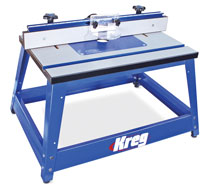
New Omnijigs from Porter-CablePorter-Cable’s Omnijig has earned its reputation as a dependable and accurate dovetailing system over almost two decades. Arriving soon are two new Omnijig Joinery System models: the 16 in. Model 55160 and the 24 in. Model 77240. Both models share important features. They come completely assembled and include a stabilizer bar that keeps the router from tipping forward. It also deflects chips down to the floor (an accessory dust chute is available). Dedicated set-and-forget stops position each template. According to the manufacturer, that means the templates don’t have to be readjusted when you change from one operation to another. Onboard depth gauges make it easy to accurately set the router bit’s height. Onboard instructions remind you how to set up each operation, so you won’t have to reread the owner’s manual each time you use the jig (incidentally, each jig comes with an instructional DVD featuring Norm Abrams). Both jigs accept stock up to 1-1/2 inches thick.
Each model is uniquely outfitted. The 16 in. 55160 is equipped with a template for cutting fixed half-blind dovetails in a single pass (think production-style drawers). This template also allows you to cut sliding dovetails. A 16 in. variable finger template will be available as an accessory. The 24 in. 77240 comes with a variable finger template for cutting both full and half-blind dovetails. This template features split fingers that allow adjusting the width of the pins as well as their location. A 24 in template for cutting production-style half-blind dovetails will be available as an accessory.
Source
Porter-Cable, www.deltaportercable.com, (888) 848-5175, 16-in Omnijig Joinery System Model 55160, $429; 24-in. Model 77240, $599.
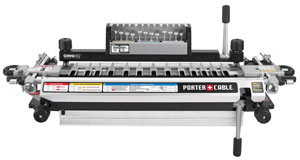
Cast-Iron Top Router Table
Bit by bit, high-end router tables are beginning to look more like classic shapers, the heavy-duty workhorse machines used in professional shops. Bench Dog has taken the latest step along that path with the introduction of a substantial cast-iron top. Other than the obvious virtue of being almost indestructible (Bench Dog calls it “bomb-proof”), a cast-iron top will stay as flat as the top of your tablesaw, which is critical for precision routing. You can also purchase this top separately and bolt it to your tablesw, replacing the right-side support table.This top is part of a modular set of router table combinations from Bench Dog which allow you to mix and match from three types of tops (cast iron, solid phenolic, and MDF) and three types of bases (Baltic Birch or melamine closed stands, and a Baltic Birch open stand). You can also add drawers, doors, an external power switch, and locking casters as accessories.
Source
Bench Dog Tools, www.benchdog.com, (800) 786-8902, ProMAX Complete, Model 40-087, $869; ProMAX top only, with fence, Model 40-031, $399.
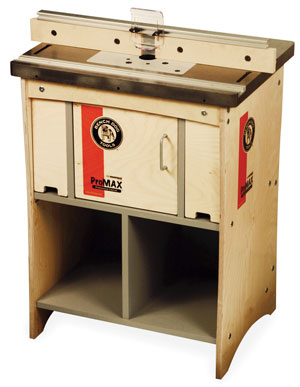
Digital Plunge Router
Digital readout has finally arrived on a mainstream router. This new 10-amp plunge router from Craftsman has an integrated LED screen that allows you to precisely set the depth of cut, in fractions of an inch or millimeters, without using a scale or ruler.
Adjusting the depth of cut on many plunge routers can be a real hassle, but not on this machine. The Craftsman system is easy to use because it’s so intuitive. As with all plunge routers, the first step is to lower the bit until it touches your workbench and engage the plunge lock lever to hold the bit in position. Next, rotate a depth-of-cut knob to lower a stop rod until it contacts the router’s base. Standard procedure so far, but now comes the new, digital part. Press a zeroing button, then dial up the stop rod. As you turn this knob, the readout screen clearly indicates how deep the bit will cut, to the nearest 1/64-in. A simple twist of another knob locks the stop rod in place, and you’re ready to go.
Other good features on this router include 1/4-in. and 1/2-in. collets, variable speed, soft start, a conveniently located on/off switch, and a dust shield and dust port. This router would work well in a router table, but it lacks a couple of user-friendly features. Although you get a long extension knob for setting the height of a bit from underneath the table, you can’t raise the collet high enough to change bits from above the table. Another small problem: when the router’s upside down, the digital readout is also upside-down; it would be nice if the readout had a button for flipping the numbers.
Source
Sears, www.sears.com, (800) 349-4358, Craftsman Digital Router, Model 17517, $140.
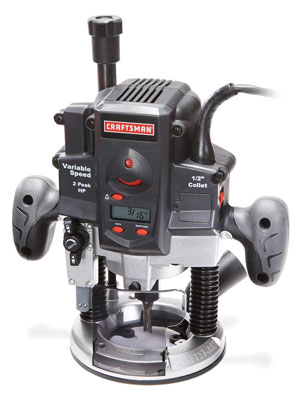
Economical Through Dovetail Jig
Forget worrying about limited dovetail jig capacity. The ChestMate dovetail jig allows cutting through dovetails anywhere on boards of any width. The process is pretty simple. The jig has an indexing pin that fits 1/8-in. kerfs sawn in a story stick that you make: You mark the story stick as you lay out the pin locations on the board and then cut the kerfs. When the story stick is indexed and clamped onto each workpiece, the saw kerfs position the jig for each socket and pin. The jig has dedicated inserts for cutting the sockets and the pins. You cut the sockets first with a dovetail bit (top photo, at right). Reposition the story stick on the second board to cut the pins (bottom photo). Install a straight bit in your router and the pin insert in the jig. The pin insert allows adjusting the pin width to fit the sockets you’ve already cut. Once you’ve dialed in the perfect pin width on a test piece, you’re good to go. To orient the joint with half-pins at the ends, instead of half-tails as shown, you’ll need a longer story stick with kerfs at the ends of the workpiece. Routing dovetails with this jig is precise, but it isn’t very fast, because you have to reposition the jig to cut each socket and pin. For widely-spaced pins, a third routing pass is required to clean out the waste. The ChestMate is designed for use with 3/4-in.-thick stock and routers with 6-in.-dia. bases. Inserts for 14-degree and 7-degree dovetail bits are included with the jig. You supply the router bits and guide bushing.
Source
Prazi USA, www.praziusa.com, (800) 262-0211, ChestMate Dovetail Jig, PR3900, $99.
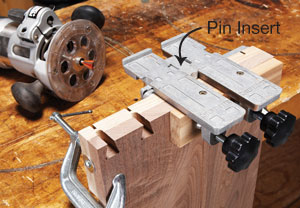
|

|
Larger-Capacity Akeda Jig
We gave the 16-in. Akeda dovetail jig our Editor’s Choice award last year because it was precise and easy to use. Akeda has recently introduced a 24-in. model, suitable for a blanket chest or other large casework, using the same clever system of snap-in, indexed guide fingers.
The Akeda DC16 and BC24 jigs excel at creating variable-spaced half-blind or through dovetails. (Variable-spaced dovetails generally have wide tails and narrow pins, following the tradition of hand-cut work.) The guide fingers may be positioned anywhere along the jig in 1/8-in. increments. These jigs offer five different dovetail angles, from 7 degrees to 20 degrees, for 1/4-in. to 3/4-in.-thick stock. (A new 6-degree bit and pin guide for 1-in. stock will be available sometime this year.) Why all the choices? Akeda suggests that dovetails with a wide angle look best in thin stock, and are stronger, while dovetails with a narrow angle are best used for thick stock. These angles are produced by using five matched sets of guide fingers and dovetail bits. Using the Akeda is very simple. You don’t have to adjust the jig or do a lot of trial-and-error cutting to get the joint to fit right. The key to this simplicity is a set of dovetail bits and Porter-Cable-style guide bushings manufactured by Akeda. Standard bits and bushings won’t work. The basic jigs do not come with any bits, however; they’re available in various sets to suit your needs. Akeda bits have 8-mm shanks, which produce less vibration than bits with smaller 1/4-in. shanks. You’ll need a reducer, available from Akeda, to use them in a 1/2-in. collet. The dust collection port, which works very well, is a $30 accessory.
Source
Akeda, www.akeda.com, (877) 387-6544, Akeda BC24 Blanket Chest Jig, $440; BC24 Jig, 7 pc. Bit Set and Dust Collector Kit, $499.
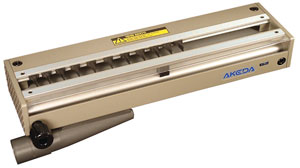

|
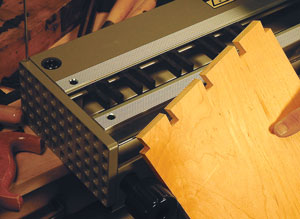
|
Light Duty Plunge Router
The T4EK, a compact plunge router from Trend Routing Technologies, is equipped with a 1.1-hp motor and electronic variable speed from 11,500 rpm to 32,000 rpm. Other features include a pressed steel edge guide, a three-stage turret-style depth stop, a spindle lock to facilitate bit changes and a dust collection housing with a 1-3/8-in.-dia. hose port. A Trend guide bushing and an adaptor plate for Porter-Cable-style guide bushings are also included. The T4EK can be used with several Trend routing jigs, including both dovetail jigs and both ellipse jigs. It can also be removed from the base and used as a rotary tool.
Source
Trend Routing Technology, www.trend-usa.com, (270) 872-4674, T4EK Plunge Router, $129.
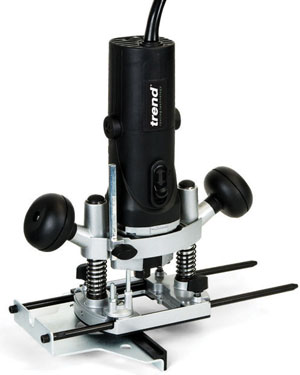
Router-Table-Friendly Machines
Freud’s newest line of routers will make your router-table setups a lot easier: you can raise, lower, and change bits from above the table, rather than by reaching underneath it. These new routers are available in three packages: a 13-amp, 2-1/4-hp fixed-base machine, a 2-1/4-hp combination kit containing interchangeable plunge and fixed bases, and a 15-amp, 3-1/4-hp plunge router. All of the motors have variable speed; their bases have openings that can handle bits up to 3-5/8-in.-dia. The plunge router bases have two access holes for above-the-table adjustments. One allows you to raise and lower the bit; the other lets you engage a shaft lock when changing bits. You use the same hex-ended tool for both adjustments and a convenient crank-handled wrench for loosening and tightening the router’s self-releasing collet. The fixed bases have two holes as well–one for loosening and tightening the motor housing from the base, the other for raising or lowering the bit. The shaft lock automatically engages when the collet is raised above the table. All in all, this is a very clever system, and it works extremely well, although we wish the hex-ended adjustment tool had a ratcheting mechanism! You’ll need to drill additional holes in your router plate to access the adjustment screws.Even out of the router table, these routers are easy to adjust. All of them have a micro-adjust knob conveniently located near the top of the router; one-quarter turn of the knob varies the bit depth by 1/32-in.
Source
Freud, www.freudtools.com, (800) 334-4107, 2-1/4-hp fixed base router, FT1700VCEK, $170; 2-1/4 hp combination kit, FT1702VCEK, $200; 3-1/4-hp plunge router, FT3000VCE, $290.
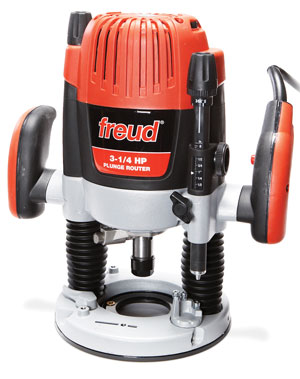
|
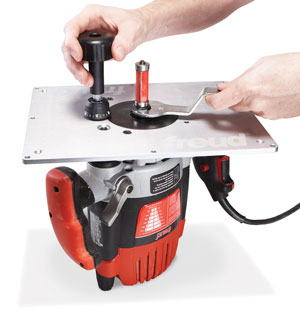
|
Screw-Slot Bits
Have you ever seen a big, ugly crack in the lid of a chest? Underneath, you’ll probably find a few cleats running across the grain to hold the lid flat. Chances are the cleats’ screws caused the crack by preventing the lid from shrinking and swelling with the seasons. It’s a classic mistake.
Two new 1/2-in shank carbide bits from CMT offer a quick way to deal with this wood-movement problem and many others, such as fastening a solid-wood tabletop to a base. In one operation, they allow you to plunge-cut a long, counterbored slot for screws to slide back and forth, which allows solid wood to shrink and swell without cracking. One bit is designed for #8 flat head screws, the other for #8 pan head screws, plus washers. The bits work in wood up to 1-in. thick.
Source
CMT, cmtusa.com, (888) 268-2487, Flat Head Screw Slotting Bit, 813.601, $37; Washer Head Screw Slotting Bit, 813.701, $37.

|

|
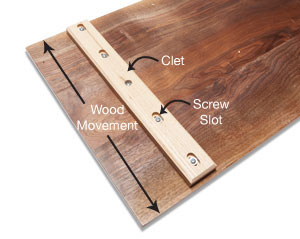
Float Through Your Routing Tasks
If you’ve ever played a game of air hockey, you’ll appreciate how a router might feel floating on a cushion of air. The Betterley Air-Glide Router Base mounts onto most routers in minutes. Even big 3-hp routers glide with ease. Surface scratches are now a thing of the past. With the cutter alone providing resistance, the job of controlling the router is made easier with the Air-Glide. We tried the base on edge cuts (top photo at left) to see how the base performed when over half the air jet holes are hanging in thin air. There’s still plenty of lift and the router slid with ease. Additional subbases are available with different center hole diameters, including one sized for Porter-Cable template guides. There’s even a square subbase with an offset hole that gives you three dimensional steps, 1/8-in., 1/16-in. and 1/32-in. from different edges. This allows you to make your initial cut followed by a slight clean-up pass simply by rotating the router. Note: At a minimum, you need a 5CFM @90-psi compressor for the Air-Glide to keep your router afloat.
Source
Betterley Industries, Inc., www.betterleytools.com, (800) 871-7516, Air-Glide Router Base, $150; Round Sub-Base, $29; Square Sub-Base, $49.

|
 |
Feature-Packed Plunge Base
Porter-Cable’s state-of-of-the-art 890-series variable-speed 2-1/4-hp routers now have a plunge base to match. The new Model 8931 (it replaces the old model with the same number) has been completely redesigned. Machined brass bushings and steel guide rods now guide the plunge mechanism for smooth operation. Through-the-column dust collection directs the vacuum hose up over your shoulder, so it’s out of the way. A swiveling six-position turret allows precise plunge depth control. An opening in the base’s motor housing provides access to the router’s body-mounted switch, so you can cut the power without removing your hands from the pommels. The 8931 is available separately and in several multi-base 890-series router kits.
Source
Porter-Cable, www.deltaportercable.com, (888) 848-5175, Plunge base Model 8931 $115; Multi-base kits: #893PK (router, plunge base and pommel-handle fixed base), $269; #894PK (router, plunge base and D-handle fixed base), $289; #895PK (router, plunge base and pommel-handle fixed base with above-the-table adjustment tool), $289.
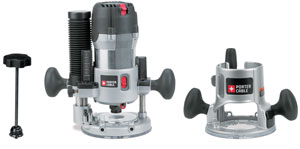
Multi-Function Router Base
The Router Buddy is a 7-in.-dia. base plate that’s bored to fit most popular routers. It’s equipped with an integral edge guide/circle-cutting jig and a center hole that’s counterbored to accept Porter-Cable guide bushings. Changing from one operation to another takes only seconds. The circle-cutting jig routs circles from 2-in.-dia. to 18-3/8-in.-dia. Install the fence and you’ve got an edge guide that allows routing dadoes and grooves up to 8-1/4-in. from the edge of the workpiece. This setup is compact and light as a feather, so it doesn’t upset the router’s balance. Attach the included half-rounds and you can rout grooves parallel to rounded edges. The half-rounds are also used during installation, to center the base around the bit shaft. The Router Buddy System includes extension rods, adjustable pivot pins and a cross-routed base. It extends the Buddy’s versatility by adding the capacity to cut circles up to 60-in. in diameter and ellipses up to 58-in. by 46-in. You can vary the difference between major and minor ellipse axes up to 12 inches.
Source
Practical Technologies, LLC, www.practical-technologies.com, (603) 818-8442,
Router Buddy, $70; Router Buddy System, $200.

|
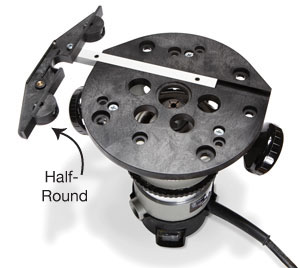
|
Super Dovetail Jigs
Leigh Industries’ Super Jigs present many virtues found on Leigh’s legendary D4R dovetailing jig. Available in 12-, 18- and 24-in. models, there’s a Super Jig priced to fit every budget. Super Jigs allow cutting variably-spaced through and half-blind dovetails, fixed half-blind dovetails in a single pass, sliding dovetails and box joints. Half-blind dovetail joints can be rabbeted, to create lipped drawer fronts. Quick-action cam clamps make it easy to install and remove workpieces. Super Jigs require simple assembly. Plan to spend a while with the owner’s manual. It’s fully illustrated and well written, so it’s easy to read and understand. Switching from one operation to another requires minor changes, such as flipping over the guide finger assembly or installing snap-in adaptors—a small price to pay for the jigs’ versatility. A handy pull-out quick-reference set-up guide stores under the jig. Three router bits and Leigh’s new “e-Bush” (left photo, above) are included with each Super Jig. The e-Bush is an eccentric guide bushing that’s used to adjust the fit of sliding dovetail and box joints. The Super Jig is shown above with the vacuum and router support (VRS) installed. An added-cost accessory we recommend, the VRS corrals dust and adds front support that will keep your router from tipping.
Source
Leigh Industries Ltd, www.leighjigs.com, (800) 663-8932, Super Jig 12, $219; Super Jig 18, $299; Super Jig 24, $369; VRS (vacuum router
support), $72-$84, depending on jig size.

|
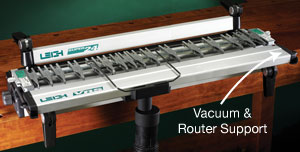
|
Here are some supplies and tools we find essential in our everyday work around the shop. We may receive a commission from sales referred by our links; however, we have carefully selected these products for their usefulness and quality.




